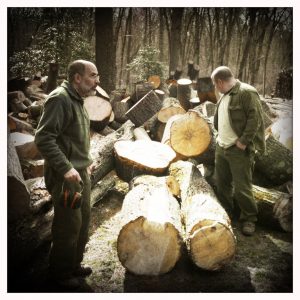We may receive a commission when you use our affiliate links. However, this does not impact our recommendations.
With the release of the long-awaited book “Make a Joint Stool from a Tree,” I hope to get many more reports like this one from woodworker Wilbur Pan in New Jersey.
He and some fellow members of the Central Jersey Woodworkers Association (cjwa.org) started in on building joint stools last weekend at a woodlot owned by Dan Stillwell, who owns a tree service.
The guys picked up some red oak logs and split them into quarters using a log-splitter, and then took them to the workshop of John Aniano where they began riving the stock by hand, according to Wilbur.
“Riving the red oak went a lot easier once I figured out I could whack the bejeezus out of the wedge without blowing anything up,” Wilbur wrote. “We got all the logs split down to sixteenths, and split out the juvenile wood… I’ve never been a fan of red oak, but this split red oak is really something else.”
Interestingly, this group chose to build a joint stool before the new book came out in March, but I have no doubt they will find it useful as they cut the joints and assemble their stools. (You can read more about the day’s activities at Bob Rozaieski’s blog here.)
 Authors Jennie Alexander and Peter Follansbee spent about 20 years researching 17th-century joinery in order to write this books, which is aimed at woodworkers, not furniture collectors. They traveled all over the world to examine examples of 1600s woodwork, which is the best historical record of how these pieces were built. There aren’t a lot of textual sources about the woodworking of that day.
Authors Jennie Alexander and Peter Follansbee spent about 20 years researching 17th-century joinery in order to write this books, which is aimed at woodworkers, not furniture collectors. They traveled all over the world to examine examples of 1600s woodwork, which is the best historical record of how these pieces were built. There aren’t a lot of textual sources about the woodworking of that day.
Using the tool marks they found on the furniture and the limited written sources, Alexander and Follansbee began building joint stools, chests and chairs in their shops to try to piece together how they were made efficiently and with a limited number of tools.
The result is “Make a Joint Stool from a Tree,” a 128-page exploration of the methods used by 17th-century joiners to make a joint stool – a splay-angled stool with turned (or chamfered) legs. These stools were built without glue or clamps, and yet have survived 300 years of use. The secret: draw-boring.
But beyond discussing what joinery they used, Alexander and Follansbee dive deep into how they made the joints using stock that was cleaved – not sawn – from a tree. This stock is rarely rectangular with square edges or ends, so it might seem like an impossible challenge to make a project like this.
Yet the authors deduced how these joint stools were made with a minimum amount of fuss and a great amount of efficiency. It involves changing your mindset – to stop thinking like a woodworking machine and learning how to work sympathetically with the material and your tools.
I had the great pleasure of editing “Make a Joint Stool from a Tree,” and I am pleased to say that ShopWoodworking.com now carries this landmark book. Alexander’s first book, “Make a Chair from a Tree,” was a turning point for the craft and people who work with green wood and hand tools. This second book is likely to become a standard reference on early joinery.
But don’t take my word for it. Here’s what Erik Gronning, a vice president of Sotheby’s in the American Furniture Department, had to say:
Good gracious what a wonderful book. I loved it! It has found a good home on my bookshelf between American Seating Furniture: 1630-1730 and American Furniture in the Metropolitan Museum of Art, Volume 1, Early Colonial Period. The discussions are great and the photographs are priceless. The overall quality of the publication is spectacular. This is a must read for anyone who studies early American furniture. Now I cannot wait till your book on “Make a Chest from a Tree.”
If you are interested in reading more about the book, check out the description in the store at ShopWoodworking.com. The book is available with free domestic shipping.
And let’s hope we get some more dispatches from the Central Jersey woodworkers group that is tackling this project. I cannot wait to see their finished stools.
— Christopher Schwarz
Here are some supplies and tools we find essential in our everyday work around the shop. We may receive a commission from sales referred by our links; however, we have carefully selected these products for their usefulness and quality.











Can the book, “Making a Chair from a Tree” still be had? Can’t find it.
I want to see someone make a joint stool FROM new jersey – but that’s just the Pennsy in me…
Is Jennie Alexander related to John D? Your piece infers that she wrote the first classic